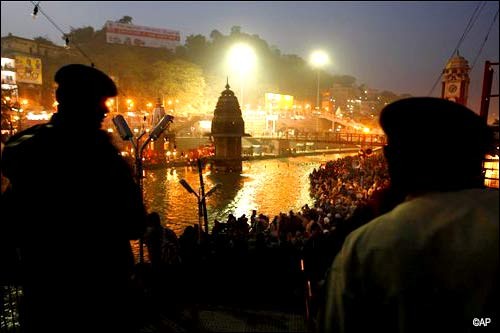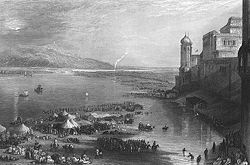Kumbh Mela begins in Haridwar


As the night sets in at Haridwar
Haridwar, Jan 14: Millions have flocked to Haridwar on the banks of Ganga at the foot of Himalayas to join a three-month long festival which comes once in twelve years. Touted as the largest congregation, Kumbh Mela as it is called locally got underway with over 25 lakh people taking a dip in the Ganga on Thursday. The occasion was ‘Makar Sankranti’ — the day when the sun starts to move northwards marking the decline of winter and start of Uttarayan.
The festival’s origins can be traced back to a Hindu myth which saw gods and demons fight over a pitcher.
According to mythology, in the beginning of all creation, the gods were placed under a curse that made them weak and cowardly. Brahma, the creator god, advised them to retrieve the kumbh (pitcher) containing the nectar of immortality.
The gods sought help from the demons and, together, they churned the primordial ocean to bring up the nectar.
When Dhanwantari, the divine healer, appeared with the kumbh containing the nectar, a great fight over the pitcher ensued between the gods and the demons, and the gods eventually won.
During the fierce battle in the sky, a few drops of nectar fell in four different places: Allahabad, in the state of Uttar Pradesh, which sees the confluence of the rivers Ganga (Ganges), Yamuna and Saraswati; Haridwar in Uttar Pradesh, where the Ganga enters the plains from the Himalayas; Ujjain in Madhya Pradesh which lies on the banks of the Ksipra river; and Nasik in Maharashtra, which is on the banks of the Godavari River.

A view of the kumbh mela in Haridwar in the 1850s
The Kumbh Mela alternates between these four places and takes place every three years. Once every 12 years, a grand Maha Kumbh Mela is held. The next will be in Allahabad in 2013.
Jan 14, 15, 20, 20; Feb 12; March 15, 16, 24, 30 and April 14 and 28 are considered as the most auspicious days for a dip in the Ganges during the Khumb. April 28 happens to be the last day of the congregation
-
Book Shelf
-
 Book Review
DESTINY OF A DYSFUNCTIONAL NUCLEAR STATE
Book Review
DESTINY OF A DYSFUNCTIONAL NUCLEAR STATE
- Book ReviewChina FO Presser Where is the fountainhead of jihad?
- Book ReviewNews Pak Syndrome bedevils Indo-Bangla ties
- Book Review Understanding Vedic Equality….: Book Review
- Book Review Buddhism Made Easy: Book Review
- Book ReviewNews Elegant Summary Of Krishnamurti’s teachings
- Book Review Review: Perspectives: The Timeless Way of Wisdom
- Book ReviewNews Rituals too a world of Rhythm
- Book Review Marx After Marxism
- Book Review John Updike’s Terrorist – a review
-
-
Recent Top Post
-
 Commentaries
Impasse over BRI Projects in Nepal
Commentaries
Impasse over BRI Projects in Nepal
-
 CommentariesNews
Yet another Musical Chairs in Kathmandu
CommentariesNews
Yet another Musical Chairs in Kathmandu
-
 CommentariesTop Story
Spurt in Anti-India Activities in Canada
CommentariesTop Story
Spurt in Anti-India Activities in Canada
-
 NewsTop Story
Nepal: Political Stability Under Threat Again
NewsTop Story
Nepal: Political Stability Under Threat Again
-
 NewsTop Story
Accountability Tryst With 2024 Ballot….
NewsTop Story
Accountability Tryst With 2024 Ballot….
-
 NewsTop Story
What Would “Total Victory” Mean in Gaza?
NewsTop Story
What Would “Total Victory” Mean in Gaza?
-
 CommentariesTop Story
The Occupation of Territory in War
CommentariesTop Story
The Occupation of Territory in War
-
 CommentariesTop Story
Pakistan: Infighting in ruling elite intensifies following shock election result
CommentariesTop Story
Pakistan: Infighting in ruling elite intensifies following shock election result
-
 CommentariesTop Story
Proforma Polls in Pakistan Today
CommentariesTop Story
Proforma Polls in Pakistan Today
-
 CommentariesTop Story
Global South Dithering Away from BRI
CommentariesTop Story
Global South Dithering Away from BRI
-
AdSense code



















